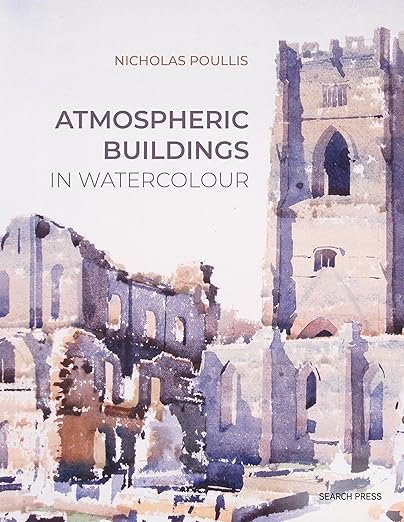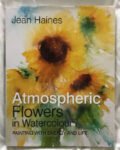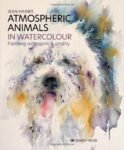176 pages. This book is about Jean Haines' atmospheric style of painting as much as…

Atmospheric Buildings In Watercolour
So, yes, as I was saying, I bought a couple of books the other day that I thought I needed. This is the second one. It’s a 144 page paperback on painting buildings in watercolour. There are a couple of people I know who are thinking of challenging me to paint their houses and I figured I might read this book first and see if it could teach me something. And I liked the look of some of the artwork that I’d seen inside the book in online previews.
We start off with about 40 pages that are, quite frankly, a waste of paper. If you’re not going to write a book for the complete beginner, you really don’t need to be telling us that we’ll be needing brushes, paint and paper. I was in a pretty bad mood by the time I got past this. So condescending. That means he talks down to people. Joke.
But after that, we get to the meat of the book with sections on
- Choosing a subject
- Simplification
- Drawing and perspective
- Painting light
- The order of painting (i.e. light to dark)
- Continuous improvement
and there are six demos (one of them only a demo of the initial pencil drawing) interspersed in there, generally themed around the subjects of the sections they appear in.
Going through those individual sections
- The advice on choosing a subject was useful, if a little light. There was some good advice in there on something that I’d never thought about before but that feels really obvious now I it’s been pointed out to me.
- There was nothing really new for me in the simplification section.
- Drawing and perspective, like choosing a subject, had some stuff in there that I should have known and could have worked out for myself but had never thought about. And I found it refreshing that Nicholas seemed to start from the assumption that we’d already been taught about perspective, and how he just added extra advice. Although this does make me more annoyed by how he assumed in the first 40 pages that I knew absolutely **** all.
- The section on painting light was a little disappointing but Catherine Beale’s book is so good that nothing else will do for me anyway. And the actual paintings in this section were inspiring.
- I didn’t learn much from the order of painting but it was absolutely essential to include it and I did like the examples shown
- And, finally, the section on continuous improvement was pretty good. I didn’t learn anything but I felt better after reading it as Nicholas’ attitude is so similar to mine. Be your own worst critic, accept that there will be periods of time when it doesn’t feel like you’re improving, keep trying different things.
The demos were worded as instructions rather than as demonstrations but I don’t think the knitting pattern brigade will like them. I found it hard to match up the words describing steps 1 to 5 with the accompanying photos. But, what with me not wanting to copy someone else’s work, that didn’t bother me as much as it will bother others.
The best thing about this book is probably the artwork. I probably learned more from looking at the paintings and trying to work out what the author did than I did from reading the text. What leaps out at me most from the paintings is the texture and the shadows. The texture comes from the granulating colours he uses: cobalt blue, French ultramarine, viridian, cadmium red and potters’ pink. His use of potters’ pink, in particular, is pretty extensive. He seems to use it everywhere (like I do with garlic) except in the skies and this is something I’ll be doing when I get back to drawing buildings. His shadows are great too, but there’s plenty of talk about them in the text.
In the end, though, while there are some interesting paintings in there to look at, there’s just not enough in the way of interesting tips for me to give this one that third palette. And those first 40 pages would be enough to swing the verdict downwards if it were close otherwise. This is a two palette book for me, meaning that, while I don’t regret buying it, it’s not a book that I’d replace if I lost my entire library. You may appreciate it more than me though. Read my review, find an online preview and make your own conclusions. The search for a great book on painting buildings goes on.
🎨🎨








Leave a Reply